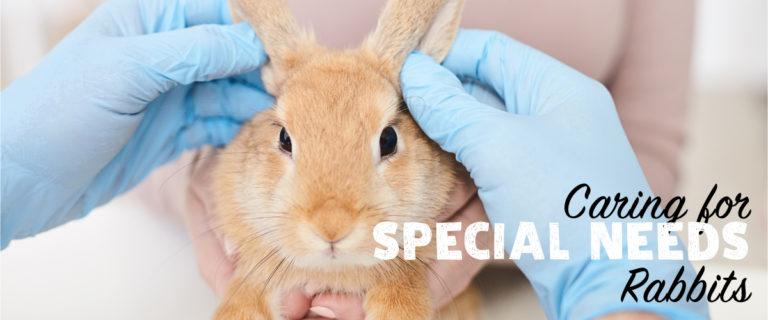For the past 30 years, I’ve lived with rabbits, during which time they’ve patiently (some not so patiently—even the kindest rabbits have their limits) taught me a lot. Especially the special-needs bunnies. I also volunteer for a rabbit rescue group that takes in special-needs bunnies, as well as those who need hospice care.
Some bunnies have come into my life disabled, and some of them became special needs due to injury, illness, congenital disorder, or old age. Regardless the cause, you need to know this up-front: Caring for a special-needs bunny requires a lot of work, commitment, and patience. And time. Probably more than anything else, it takes time.
And, of course, love.
It can also cost more than what you might spend on an able-bodied bunny. Medications, special trips to the vet, habitat materials, and special diets, to name a few, can add up.
If you do decide to become a special-needs caretaker, speaking from experience, it’s satisfying to know that you’ve made a real difference in a bunny’s life. But the love and gratitude you get in return are by far the best rewards.
I know this.
This the first in a series of four blogs about caring for disabled and special-needs rabbits. In this blog, I give an overview of three of my special-needs bunnies to illustrate some of the issues and concerns I’ve had, how I learned what to do, and where I’ve found the best information. Later blogs will give more in-depth information.
Without further ado, let me introduce you to Mr. Gilbert, Robbie, and Cassie.
Mr. Gilbert
Mr. Gilbert was an elderly Blue Rex gentleman who had arthritis that made it difficult for him to hop. When he developed head tilt, he became immobile. He was completely reliant on me.
My concerns over how to deal with Mr. Gilbert’s situation were: habitat, incontinence, drinking and eating, and mental stimulation. However, the number one concern—as with all companion rabbits, special needs or not—was comfort.
Love is always a big part of comfort, and everyone who met Gilbert loved him.
Robbie
Robbie is a big handsome Flemish Giant who, because of a birth defect, had to have his right back leg amputated. His front leg on the same side is splayed at right angles to his side.
These complications make Robbie partially immobile.
He gets around by pushing off with his one back leg, which has grown muscular and powerful with use. He scoots and drags himself forward without too much trouble, especially when it’s for treats. Robbie also thrives on love and attention, which makes him the perfect ambassador for disabled house rabbits at educational events. He’s a born showman.
My concerns over Robbie are much the same as those for Mr. Gilbert, but because Robbie is only 3 years old and partially immobilized, he needs more room to move and a lot of interaction with other members of the household.
Cassie
Cassie is a white lop with butterscotch ears and spots down her back. She has a voracious appetite for food and life. She does bunny 500s in the evenings with a binky or two thrown in for effect. If she wants food, she growls and lunges at my feet, pushing me into the kitchen. She’s a little spitfire.
You’d never guess she suffers from a congenital disorder—megacolon.
Not a lot is known about megacolon, other than it’s linked to a rabbit’s color and markings, and Cassie’s colored ears and pattern of spots down her back make her a prime candidate. So far, there’s no cure, only measures to keep these bunnies healthy and comfortable for as long as possible.
My concerns over Cassie are: maintaining constant vigilance over any change in her behavior, poop, and eating habits; making trial-and-error adjustments to her diet; and learning everything I can along the way.
Reliable Resources
Thirty years ago, what little information there was about rabbits came from breeders. Vets who knew anything about bunnies were hard, if not impossible, to find.
But in 30 years, we’ve come a long way.
Now, there are Facebook groups and sites devoted to people with companion rabbits. There are house rabbit clubs and groups, some with international memberships. There are even bunny yoga classes.
Beware, though, that there is quite a bit of BAD info out there as well. You’ve got to evaluate your source.
There are books written by authors who are house-rabbit savvy.
There’s a lot of research being done on rabbit health, and subsequent papers published online.
And because more people are choosing to share their lives with rabbits, there’s a bank of information that has accumulated.
I rely on these resources, as well as my own experience and that of my fellow special-needs rabbit caretakers.
Here are a few of the reliable resources I use:
Sites
http://www.mybunny.org/info/caring-for-the-partially-disabled-rabbit/
http://www.rabbit.org/journal/1/critically-ill.html
http://www.rabbit.org/journal/3-2/disabled.html
http://rabbit.org/house-rabbit-reading-room/
http://rabbit.org/category/care/elderly-and-special-needs/
Facebook Groups
https://www.facebook.com/groups/201759429869484/
Disabled Rabbits
https://www.facebook.com/groups/547897018681987/
Books
Harriman, M., “House Rabbit Handbook,” Drollery Press
Moore, L.C., and Smith, K., “When Your Rabbit Needs Special Care,” Santa Monica Press, 2008
Harriman, M., “Assisted Living for Special-Needs Bunnies,” Drollery Press, 2017
Another good source of information is the rabbits themselves. While books, sites, and Facebook groups are valuable, each bunny is an individual, with his own special needs. Watch your rabbit companion. And listen to him.
This is, by far, is the best source of knowledge.
Read more on this topic in the next installment HERE.





